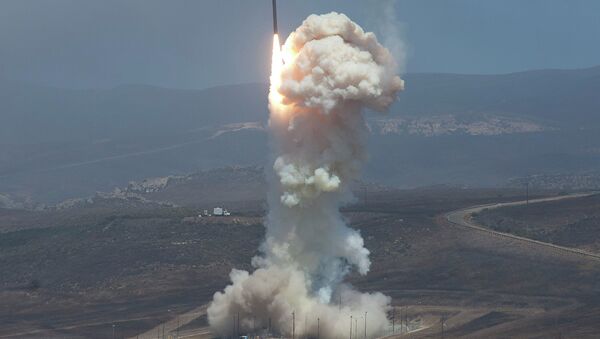Washington, over time, has come to rely extensively on the threat of massive retaliation to deter its perceived adversaries like nuclear powers Russia and China, instead of actually building real defences, opting for the cheaper solution. However, it may soon have to face the consequences of its decisions in the early decades of the 21st century, believes Loren Thompson, a Senior Contributor to Forbes on national security.
The analyst states that Washington spent a trillion dollars between 2001 and 2019 in Afghanistan against the Taliban, while allocating just 5 percent of that amount, $50 billion, to its own defence against a potential ballistic missile attack by a nuclear power.
The Chief Operating Officer of the non-profit Lexington Institute underscores the seeming fallacy of this decision, as it was unclear whether emerging new “potential aggressors” such as a nuclear-armed North Korea or Iran could be deterred by threats of retaliation.
In the newly-unfolding circumstances, the US opted to bolster its deterrence policy with a system that was called Ground-based Midcourse Defense, or GMD.
The name is self-explanatory, as the system that most of the $50 billion allocated towards homeland defence were spent on was meant to intercept attacking missiles in the middle of their trajectories, meaning in space.
In the US arsenal, the report relays, GMD is the only system capable of intercepting intercontinental ballistic missiles targeting the country.
Pros and Cons of GMD
One of the undeniable advantages of the Ground-based Midcourse Defense system is that it defends the entire US and as such, can potentially ward off a minor attack coming from any direction – an accidental missile launch, for example.
However, the main weakness in GMD is its ground-based interceptors. The latter would require timely upgrades to be able to rise to the challenge of potential new threats, such as that which a nuclear-armed North Korea might present, concedes the author.
The GMD currently comprises only 44 interceptor missiles in silos, while according to the report, a single incoming nuclear warhead would most likely require two to four of them.
Aware of the urgency of an interceptor upgrade, Congress has already requested that the number of these interceptors be increased by 20, with new missiles scheduled to be ready by 2022.

However, according to intelligence analysts, who have identified 49 potential improvements of enemy missiles, the nuclear arsenals of a potential adversary are anticipated to grow in sophistication, relying on the augmented use of decoys, and multiple or manoeuvring warheads. The latter would call for new-generation upgrades to be unveiled within a decade or two.
Several years ago, the Pentagon’s Missile Defense Agency (MDA) came up with a solution, hoping to redesign the “kill vehicle” atop the interceptors to become a more “agile” Redesigned Kill Vehicle (RKV), while improving the rocket boosters carrying it.
Besides using the RKV to replace the ageing kill vehicles atop the current fleet, the MDA system had planned to deploy the RKV starting in 2021 atop 20 new interceptors in Alaska, to augment the existing fleet of 44 interceptors there and in California.
It was hoped the RKV would show itself to be more reliable and cost effective than the current generation of GMD exoatmospheric kill vehicles (EKVs). The latter had demonstrated mixed test results, with the system’s intercept success rate projected to be just above 50 percent in controlled testing.
The project, however, has come up against “insurmountable problems”.
A statement by the Pentagon on 21 August 2019 said that effective the next day, the Pentagon would terminate the Boeing Company’s contract to build the Redesigned Kill Vehicle (RKV) “due to technical design problems”.
The announcement followed the decision in May to order Boeing, the lead contractor for the $67 billion Ground-Based Midcourse Defense (GMD) system, to stop all work on the new kill vehicle. Congress had set aside more than $1 billion for the RKV program, from its inception in fiscal year 2015 through fiscal year 2019.
In the wake of the demise of the RKV programme, the Defense Department suggested developing an entirely new long-range interceptor, with a new kill vehicle, a new booster, and other items to defeat the “evolving threat” as the only viable solution.
According to the author, in the near term, the problem is that next-generation interceptors simply won’t be ready before what is a “threat” might actually become a challenge in real terms.
Technical hurdles aside, testing stages and the ensuing politics are bound to slow down progress.
What Can Be Done?
The Missile Defense Agency has two basic options, believes the analyst: either upgrade existing interceptors to deal with the threat for a few more years, or concede that “dumbing down” the next-generation interceptors will make them ready much sooner.
This could serve its short-term purpose, yet eventually neither system would be up to task at hand, i.e. defending the US.
The Forbes analyst suggests that the “obvious answer” is to ensure existing ground-based interceptors maintain their efficiency for a longer term.
This is where the Boeing Company comes in, as it proposes to the Missile Defense Agency to “leverage” technologies developed under the canceled kill vehicle project to render GMD viable through 2030. After that cut-off date, a replacement is anticipated as likely available.
Boeing suggests upgrading the 20 new interceptors approved by Congress so that they are capable of coping with 85 percent of the next-generation threats.

It is believed the remaining 15 percent - perceived as arising somewhere in the mid-2030s - can only be addressed by a new interceptor.
The upgrade is offered by Boeing for the estimated cost of the failed kill vehicle project - about $2.7 billion.
Thus, according to the Forbes’ analyst, if the Missile Defense Agency has any hope of keeping up with the challenges the ever-evolving potential threats present, Boeing’s interim solution might present itself as a viable course of action.




